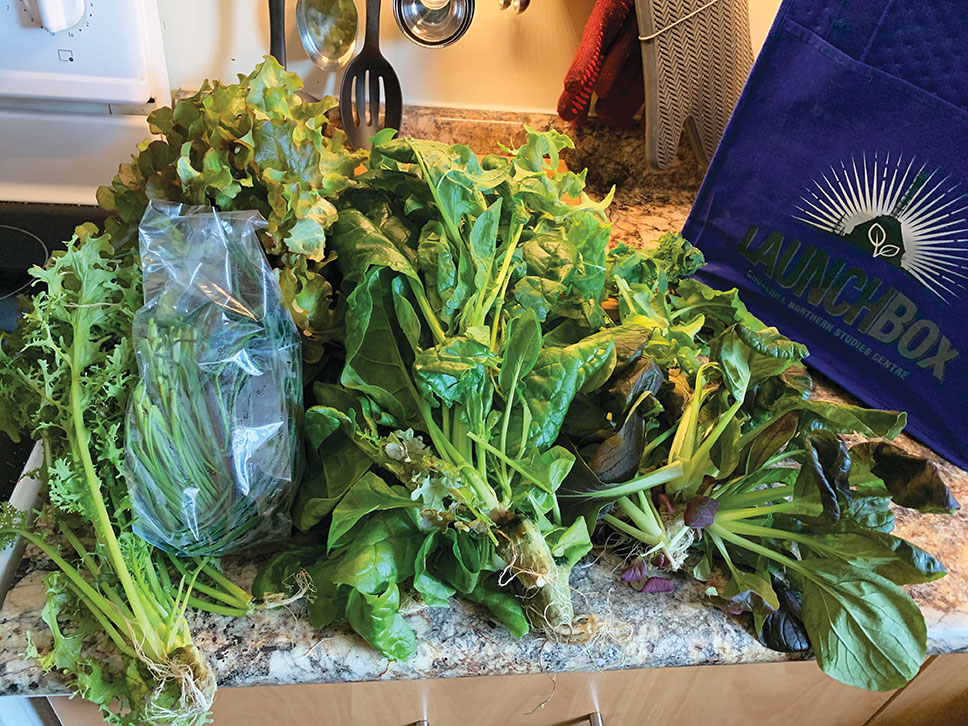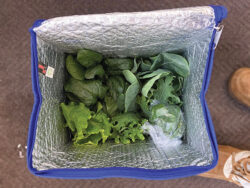
Features
Is a food box program THE right FIT for you?
Considerations and marketing tips to see if Community Supported Agriculture is a fit for your operation.
September 12, 2022 By Stephanie Gordon
 Rocket Greens, run out of the Churchill Northern Studies Centre, offers a weekly subscription of fresh leafy greens year-round in Churchill, Man.
All photos courtesy of Growcer.
Rocket Greens, run out of the Churchill Northern Studies Centre, offers a weekly subscription of fresh leafy greens year-round in Churchill, Man.
All photos courtesy of Growcer. At the peak of the COVID-19 pandemic, Community Supported Agriculture (CSA) shares saw a surge of interest because people wanted to support local growers. Plus, 52% of Canadians said they would pay a premium for locally grown indoor produce. But how do you know if CSA is a fit for your operation?
Darren Stott with Greenchain Consulting specializes in building local and sustainable food supply chains. Stott shares advantages and disadvantages of a CSA model, how to assess your market, and finally, how to market your CSA if you choose to start one.
“Don’t get into this channel if you don’t want to get close to your customer. If you don’t want to be communicating and connecting with them,” Stott starts. “It’s about relationships, not just the food you produce.”
Advantages of Community Supported Agriculture
CSAs work best for small- to medium-sized food producers who want to sell their product directly to customers. A CSA model allows you to develop strong local relationships, has low startup costs, good margins, and is a growing service.
The CSA model – where customers sign up for CSA food box subscriptions over a few months – allows your operation to receive money upfront so you can invest in your business at the start of the growing season. It also allows for consistent revenues. If the weather is poor, you might find low attendance and revenues with farmers’ markets and gate sales. With CSAs, if you do the hard work in the beginning of the season to sign up customers, it will pay off with consistent revenues during the season.
Finally, there’s flexibility. “We joke that customers get what they get, and they can’t get upset,” Stott says, explaining that most CSAs offer set boxes of whatever produce is in season instead of highly customizable options. Running a CSA also allows you to continue to do farmers’ markets, wholesale, or other activities with surplus product.
Disadvantages
While there is a strong uptake in customers wanting to support local businesses, Community Supported Agriculture is a small sector. Growers must still diversify and not rely on one channel for distribution. Running a CSA is also administration and customer service heavy. Extra time and money are needed to manage customers, invoices, packaging, and software programs like Customer Relationship Management (CRM) or accounting tools.
“You have to invest in dealing with customers and keeping them happy and educated,” Stott says.
Another disadvantage is the large customer turnover. Stott explains it’s normal to expect a drop after each season and spend effort on re-signing customers to fill the gap. The expected turnover is why it is so important to invest in a customer experience and a high retention strategy early on.
How do I assess if my market is good for a CSA food box?
Starting a CSA food box may seem daunting at first, but you only need around 20 customers to get started. Stott explains how most CSAs start small and grow to 100 to 200 customers with time after experimenting and finding what works best.
Before launching your CSA, survey as many people as you can. Ask friends and family, get referrals through them, and aim for at least 20 people to give you feedback. Consider using social media, online community groups, and existing community channels to find other locals to talk to.
“CSAs for a lot of people, is something new to them. It does need explaining. It is very different from going to the grocery store or farmers’ market. You have to explain paying up front, how it’s picked up, and how they don’t get to choose what’s included in the box,” Stott says.
Assess your competition. Find out what CSAs exist in your area, what they’re offering, how long they have been in business, and if they’re doing a good job or if there is a gap in the market for your product. Analyze other direct marketing services like farmers’ markets, farm stands, and gate sales that also compete for a similar customer base. Greenhouse growers also benefit from an extended growing season compared to outdoor growers – is there an opportunity in the shoulder seasons to capture some of that market?
CSAs still thrive in competitive markets
The Fraser Valley in Lower Mainland, B.C. is a good growing region with multiple grocery delivery businesses, farmers’ markets, and dozens of CSAs. Stott shares many local CSAs in the region still saw double-digit growth over the past two years despite being in a competitive market.
“Even if you’ve done your market research and find out there’s a lot of CSAs and farmers’ markets, that doesn’t mean the opportunity isn’t there,” Stott starts.
“It doesn’t matter what your competition is like, you’ve got to give it a try and as long as you’re offering a better product and a better service then there’s no reason why you can’t be competitive.”
How do I market my CSA?
An additional benefit to conducting market research is building a customer base. When you’re ready to launch your CSA, you can reconnect with everyone who offered feedback and sign them up. “The best strategy is word of mouth, making those connections and relationships,” Stott shares.
You can also market your CSA through a referral program (asking existing customers to refer friends), events, community groups, farm signage, social media, website and Search Engine Optimization (SEO), and flyers or postcards. It’s always nice to make sure people walk away with something in their hands.
“All this strategy is no good unless you have strong customer retention,” Stott reaffirms. The best marketing strategy is a customer retention strategy. It is easier to work on retaining existing customers and building strong relationships with the right customers than it is to start anew every season.

Cooler bags keep produce fresher longer and are a more sustainable option for your subscribers.
How do I keep subscribers and build my customer base?
With the importance of customer retention top of mind, the next question becomes what are good retention strategies?
It’s simple. Provide an excellent service and offer high quality products, consistency, and professionalism in all you do from how your box looks to how you communicate with customers. Most successful CSAs do not let customer attrition deter them and try hard to keep a strong base of loyal customers that will always stick around.
Another retention strategy involves a personal and insightful communications strategy. “Customers are subscribing to your CSA because they want to buy direct from the farmer, they want to have a relationship with you, they want to learn from experts like yourself,” Stott says. Consider sharing recipe suggestions, insight into how your operation works, and updates on how your small business is doing week to week. For many, your first customers might be your family and friends and they are interested in you as a person and want to see your business succeed.
On top of personal communications, use “360 communication” to keep customers in the know. From sign up to pick up – ensure your customer knows what to expect.
Also, offer customers the opportunity to get to know you better with site visits and online engagement. Use this time to understand your customer better too.
“Surprise and delight” customers with extra produce from time to time or small thoughtful touches like birthday surprises. Once you reach a certain threshold of customers (100+), it will become more important to invest in good CRM tools to keep track of customer orders, preferences, or extra notes like birthdays.
Conclusion
Community Supported Agriculture is a fit for producers who want to engage with customers, share their story, and aren’t deterred by higher administration workloads.
More information: Connect with Darren Stott directly or visit greenchainconsulting.ca for more examples on how food businesses can become greener and financially sustainable. Darren Stott shares these marketing tips and more in Growcer’s four-part webinar series on How to Start a Food Box Subscription Business with a container farm. Access the entire series, which includes a Q&A with a grower, by visiting growcer.ca/workshops.
Considerations for CSA food box programs
Advantages
- Develop strong relationships
- Low start up costs
- Operation receives money upfront
- Good margins
- Flexible for the grower
- Higher average order size
- Complementary to other
distribution channels - Unsold product can be used elsewhere
- Popular and growing service
- Consistent revenues
Disadvantages
- Small sector
- Administration heavy
- Additional costs
- Customer service heavy
- Large customer turnover
- Profits are small
Print this page